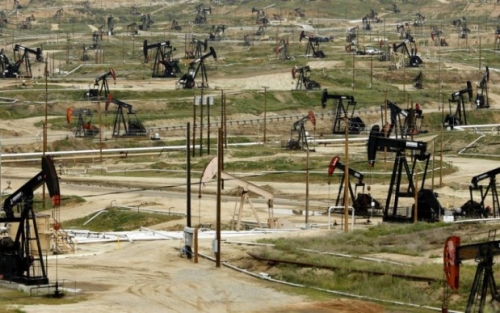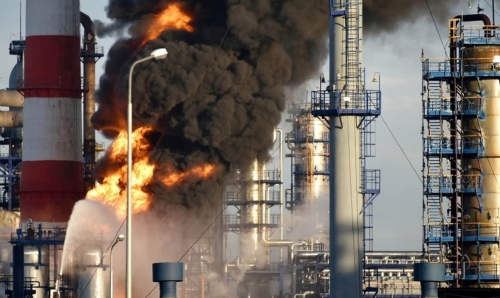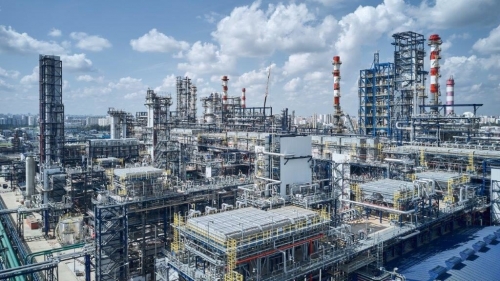Despite oil prices finishing with daily gains on Friday after new sanctions were imposed on Iran’s crude exports, oil prices ended lower week-on-week due to ongoing concerns over tariffs policy as well as increase in US crude stocks.
BKR Rig Count | The total active drilling rigs in the United States increased by 4 last week, to 586. Oil rigs increased by 1 to 480, and gas rigs increased by 2 to 100 (miscellaneous increasing by 1 at 6). Rig count in the Permian Basin stayed flat at 303 | Feb 7 | BKR NAM Rig Count
US Crude Inventories, excluding those in the Strategic Petroleum Reserve (SPR), increased by 8.7 MMbbl to 423.8 MMbbl (about 5% below the 5y average for this time of year). On the products side, gasoline increased by 2.2 MMbbl (slightly above the 5y average). Distillate fuels decreased by 5.5 MMbbl (12% below the 5y average). Total commercial petroleum inventories decreased by 2.7 MMbbl | Jan 31 | EIA Weekly Report
OPEC has replaced the EIA and Rystad Energy with Kpler, OilX, and ESAI as secondary sources for assessing crude oil production and compliance with output cuts, during their last meeting. OPEC+ also “welcomed renewed pledges by the overproducing countries to achieve full conformity and to resubmit their updated compensation schedules” before the end of the month, while “reaffirming their commitment” to the additional voluntary production adjustments plan from Dec 2024. The next meeting is scheduled for 5 April 2025 | Feb 3 | OPEC
Xi’s Careful Reply to Trump Tariffs Shows China Has More to Lose. Trump’s 10% tariffs on China took effect after midnight Washington time on Tuesday. Within seconds, Beijing announced additional tariffs on roughly 80 products to take effect on Feb. 10, launched an antitrust investigation into Google, tightened export controls on critical minerals, and added two US companies to its blacklist of unreliable entities. “A full-blown tariff war is not in China’s interest,” said Larry Hu, head of China economics at Macquarie Group Ltd. “Instead, China is likely to respond to tariffs mainly through domestic stimulus.” The question now is whether leaders of the world’s biggest economies can quickly reach an agreement | Feb 4 | Bloomberg
US President Donald Trump’s administration has imposed oil sanctions against Iran, targeting country’s shipments to China in an effort to block Iran’s nuclear arsenal development and what it described as funding of terrorist groups | Feb 6 | Upstream
Prices of fuel oil in Asia rose to match the region’s crude benchmark, with US sanctions on Russia and Iran crimping supply of the typically low-value oil product. The crack, or the relative strength of fuel oil to its raw material, narrowed in January after US sanctions on Russia reduced fuel oil supply in the market. China has been particularly affected as it uses the Russian product as a refining feedstock and for blending high-sulfur fuel oil, said June Goh, senior oil market analyst at Sparta Commodities. With sanctions on Iranian crude, “China will face a double whammy of loss of cheap crude and cheap feedstock,” she added | Feb 7 | Bloomberg
Saudi Aramco raised the price for its Arab Light oil to Asia for March by $2.40 a barrel, the biggest increase since August 2022. Recent tough US sanctions on Russian oil sent Asia’s refiners scurrying to buy replacement cargoes. The barrels that are closest in both geography and quality are pumped in the Middle East, leading to a surge in premiums for the region’s crude relative to other international benchmarks. Refining margins in Asia have also improved in recent weeks, after some processors cut back production, also helping to justify the large increase | Feb 5 | Bloomberg
China’s Oil Teapots Cut Runs to Pandemic Levels as US sanctions on Russia cut a key source of crude supply. Run rates at the so-called teapots of Shandong province edged down this week to just 43.64%, the lowest since March 2020. The teapots clustered on China’s east coast have been hardest hit by Washington’s strictest package yet of measures targeting Russian oil. Flows of their favored ESPO grade of crude from the Pacific port of Kozmino have been crippled, forcing them to reduce operations already under pressure from China’s weak economy and lackluster demand for fuels | Feb 6 | Bloomberg
The Bank of England's Monetary Policy Committee cut interest rates by a quarter point to 4.5%, reaching a 19-month low, but signaled that only two more reductions are needed to bring inflation back to the 2% target. The BOE warned that inflation will rise "quite sharply" to peak at 3.7% later this year, and downgraded growth and its estimate of the economy's growth capacity in the short term. Governor Bailey said they plan to take “a gradual and careful approach to reducing rates further” | Feb 6 | Bloomberg
Treasury Secretary Scott Bessent says the Trump administration's focus is on bringing down 10-year Treasury yields, not the Federal Reserve's benchmark short-term interest rate. Bessent believes that expanding energy supply will help lower inflation and that reducing the budget deficit will help bring 10-year yields lower. The administration's goal is to achieve non-inflationary growth, with Bessent supporting making the 2017 Tax Cuts and Jobs Act permanent to continue US economic growth | Feb 5 | Bloomberg
Trump Administration Halts Program to Expand US EV Chargers. The move targets a key source of funds to build the network of chargers that automakers have said is critical to boosting consumer adoption of battery-powered cars. The Electric Drive Transportation Association said states and businesses have already made investments under the program, and called on the Trump administration to reverse the decision | Feb 7 | Bloomberg
Looking ahead
Global elections outlook: energy on the ballot in 2025 | The 2024 U.S. presidential election brought energy policy to the forefront, with energy issues set to dominate political campaigns worldwide in 2025. In Europe, Germany's February election, following the collapse of Chancellor Olaf Scholz's coalition, could see a shift toward a more industry-friendly approach under the CDU led by Friedrich Merz, who has emphasized balancing climate goals with industrial priorities. Poland’s May presidential election will test Prime Minister Donald Tusk’s ability to advance a progressive energy agenda amid opposition from a far-right president. In the Czech Republic, former Prime Minister Andrej Babis, a vocal critic of climate policies, could return to power, while Moldova’s July elections will be influenced by Russia's role in the country’s energy supply, particularly in the Transnistria region. Norway's September elections are expected to see a change in government, but the oil and gas sector will likely remain a political constant. In Africa, Gabon’s April elections are expected to solidify General Brice Oligui Nguema’s grip on power, with limited disruptions to the oil and gas sector. Cameroon’s October election comes amid concerns about President Paul Biya’s ability to govern due to his health and growing political instability. Ivory Coast’s elections will be a key moment for its burgeoning oil sector, while in Tanzania, political tensions are anticipated ahead of President Samia Suluhu Hassan's re-election bid, though a smooth transition is expected. In the Americas, Canada’s May elections will be pivotal for the future of the country’s energy policy, as the Conservative Party’s pro-fossil fuel stance could challenge the ruling Liberals. Ecuador’s February election, amid power outages and security challenges, will test President Daniel Noboa’s popularity. Suriname’s May elections coincide with its drive for oil development, while Guyana and Argentina will see energy policies take center stage in their 2025 elections. In Australia, the May federal election will be a referendum on the Labor government’s energy policies, balancing renewables with fossil fuel development amid rising electricity costs | Feb 7 | Upstream
S&P Global Crude Oil Markets Short-Term Outlook | S&P’s average annual global oil demand growth for 2025 is forecast at 1.3 mb/d, with combined growth of naphtha, LPG and ethane representing 725,000 b/d, or 54%, of global oil demand. Jet/kerosene will continue to grow, albeit slower, as its demand returns to pre-pandemic levels. Gasoline and gasoil/diesel will take a back seat as EV penetration, LNG substitution in trucks and fuel efficiency improvements continue to unfold, especially in the US, Europe and China. The salient feature of the oil demand profile is that growth will be concentrated in emerging countries, contributing to 65% of global growth. Subpar performance is anticipated for major OECD countries such as the US, European countries and Japan. Global oil demand growth is expected to moderate at 0.8 million b/d in 2026, primarily due to softness in the US, Canada, Europe and Japan, with the growth trajectory of China to slow as gasoline and diesel demand peak, and petrochemical feedstocks take the lead. In contrast, S&P projects a significant role for emerging countries in South Asia, Southeast Asia, the Middle East, Latin America and Africa in driving global oil demand growth. On the product side, globally the share of naphtha, LPG and ethane is expected to rise, contributing 75% of the demand growth in 2026. S&P’s 2025 liquids supply forecast is expected to grow 2 mb/d y-o-y, relatively consistent with last month, with a wave of non-OPEC+ growth in the first half of the year. S&P expects global crude supply will grow 946,000 b/d, condensate up 207,000 b/d and NGLs up 492,000 b/d. For 2026, S&P anticipates growth to slow to 1.59 mb/d (vs 1.53 mb/d in last month’s report), of which 920,000 b/d is crude, 113,000 b/d is condensate and the rest is NGLs. With oil prices close to $80/b in February–March, S&P expects OPEC+ to start raising supply from April as it seeks to use its 6+ million-b/d spare capacity. How pressure from Trump impacts OPEC+ decisions and timing, along with the need for unity within the group, will influence the lag time between Trump’s calls for more output and when more OPEC+ output actually appears. 2025 outlook for Dated Brent and WTI was raised by $2/b, to $74/b and $68/b, respectively, because of higher prices to start the year. 2026 outlook was unchanged at $69/b for Dated Brent and $64/b for WTI. In alternative scenarios, if supply were to be unleashed, Dated Brent price would fall closer to $59/b in 2025 and $57/b in 2026, or alternatively, in the case of tighter supply, prices could hit $88/b in 2025 and $86/b in 2026 | Jan 30 | S&P

%20(1).png)



